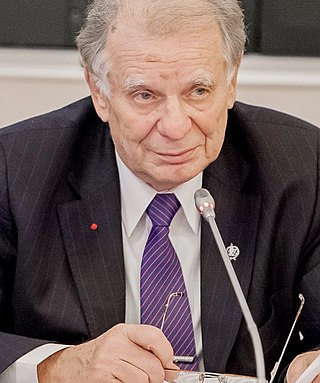
Zhores Ivanovich Alferov was a Soviet and Russian physicist and academic who contributed significantly to the creation of modern heterostructure physics and electronics. He shared the 2000 Nobel Prize in Physics for the development of the semiconductor heterojunction for optoelectronics. He also became a politician in his later life, serving in the lower house of the Russian parliament, the State Duma, as a member of the Communist Party from 1995.

The Russian Academy of Sciences consists of the national academy of Russia; a network of scientific research institutes from across the Russian Federation; and additional scientific and social units such as libraries, publishing units, and hospitals.

Abram Fedorovich Ioffe was a prominent Russian/Soviet physicist. He received the Stalin Prize (1942), the Lenin Prize (1960) (posthumously), and the Hero of Socialist Labor (1955). Ioffe was an expert in various areas of solid state physics and electromagnetism. He established research laboratories for radioactivity, superconductivity, and nuclear physics, many of which became independent institutes.

The Ioffe Physical-Technical Institute of the Russian Academy of Sciences is one of Russia's largest research centers specialized in physics and technology. The institute was established in 1918 in Petrograd and run for several decades by Abram Ioffe. The institute is a member of the Russian Academy of Sciences.
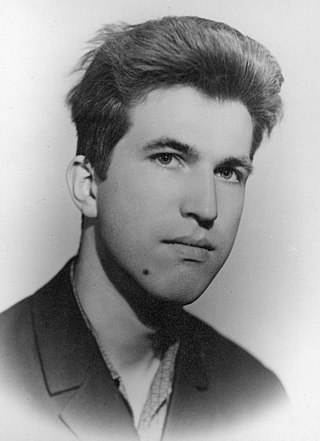
Yuri Vladimirovich Matiyasevich, is a Russian mathematician and computer scientist. He is best known for his negative solution of Hilbert's tenth problem, which was presented in his doctoral thesis at LOMI.

Peter the Great St. Petersburg Polytechnic University, abbreviated as SPbPU, is a Russian technical university located in Saint Petersburg. Other former names included Peter the Great Polytechnic Institute and Kalinin Polytechnic Institute. The university houses one of the country's most advanced research labs in hydro–aerodynamics. The university's alumni include Nobel Prize winners, such as Pyotr Kapitsa and Zhores Alferov, physicists and atomic weapon designers such as Yulii Khariton, Nikolay Dukhov, Abram Ioffe, Aleksandr Leipunskii, and Yakov Zeldovich, aircraft designers and aerospace engineers, such as Yulii Khariton, Oleg Antonov, Nikolai Polikarpov, and Georgy Beriev, and chess grandmasters, such as David Bronstein. The university offers academic programs at the Bachelor, Master's, and Doctorate degree levels. SPbSPU consists of structural units called Institutes divided into three categories: Engineering Institutes, Physical Institutes, and Economics and Humanities Institutes. In 2022, the university was ranked #301 in the world in the Times Higher Education (THE) World University Rankings, #393 in QS World University Rankings, #523 in Best Global Universities Rankings by U.S. News & World Report, and #1,005 by Center for World University Rankings.

Presidential Physics and Mathematics Lyceum No. 239, is a public high school in Saint Petersburg, Russia that specializes in mathematics and physics. The school opened in 1918 and it became a specialized city school in 1961. The school is noted for its strong academic programs. It is the alma mater of numerous winners of International Mathematical Olympiads and it has produced many notable alumni. The lyceum has been named the best school in Russia in 2015, 2016, and 2017.

Andrei Aleksandrovich Fursenko is a Russian politician, scientist and businessman. He was the Minister of Education and Science of the Russian Federation from 2004 to 2012. He is considered to be a member of the Saint Petersburg political groups under Vladimir Putin's presidency.

Dmitri Z. Garbuzov was one of the pioneers and inventors of room temperature continuous-wave-operating diode lasers and high-power diode lasers.
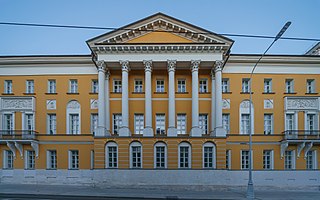
HSE University, officially the National Research University Higher School of Economics is a public research university founded in 1992 and headquartered in Moscow, Russia. Along with its main campus located in the capital, the university maintains three other regional campuses in Nizhny Novgorod, Perm and Saint Petersburg. There is also the Lyceum at the National Research University Higher School of Economics in Moscow.

Saint Petersburg Electrotechnical University "LETI" is a public university and one of the oldest Russian higher education institutions.
Yuri Andreevich Osipyan was a Soviet, Russian-Armenian physicist who worked in the field of solid state physics.

The Global Energy Prize is an international award in the field of energy industry which is given for "outstanding scientific research and scientific-technical developments in the field of energy which promote greater efficiency and environmental security for energy sources on Earth in the interests of all mankind".
The Faculty of Mathematics (FM) at the National Research University Higher School of Economics was founded in 2008 jointly by the Higher School of Economics (HSE) and the Independent University of Moscow (IUM). It offers Bachelor of Science program “Mathematics”, Master of Science program “Mathematics”, Master of Science program “Mathematics and Mathematical Physics”. The faculty also plays a key role in the HSE Graduate School of Mathematics. Since the creation of the FM, new faculty members were hired at the international market, and researchers from the USA, Japan, Canada, France, the UK, etc., joined the team. The Faculty of Mathematics has joint departments with distinguished research institutes of the Russian Academy of Science: Steklov Institute of Mathematics, Kharkevich Institute for Information Transmission Problems, Lebedev Physical Institute. Associated with the FM are three international research groups, the so-called laboratories: the Laboratory of Algebraic Geometry and its Applications, the Laboratory of Representation Theory and Mathematical Physics, and the Laboratory of Mirror Symmetry and Automorphic Forms.
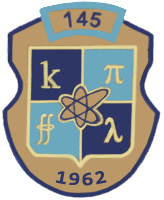
The 145th Natural Science Lyceum, officially known as Kyiv Natural-Scientific Lyceum No. 145, is a secondary educational institution, located in Pechersk District of Kyiv, Ukraine. The program of study emphasizes Physics, Mathematics, Computer Science and Chemistry.
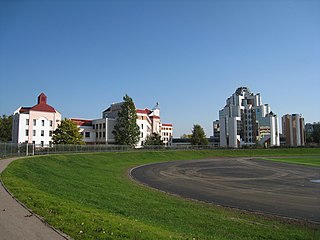
Alferov Federal State Budgetary Institution of Higher Education and Science Saint Petersburg National Research Academic University of the Russian Academy of Sciences was founded in 1997 originally as the Research and Education Center of the Ioffe Institute to integrate science and education in the field of physics and information technologies. It has the distinction of being the only university in the Russian Academy of Sciences (RAS), which is composed primarily of national research institutes. Accordingly, the word "Academic" in the university's name stems from the Academy of Sciences, the organization that unites numerous national research institutes in Russia. The St. Petersburg Academic University was founded by Zhores Alferov, director of the Ioffe Institute, vice-president of the RAS Academician and Nobel prize laureate, who served as its rector until his death on March 1, 2019.

Hasan Abdullayev was a leading Soviet and Azerbaijani physicist, scientist and public official, who served as President of the National Academy of Sciences of the Azerbaijan SSR. He was a Doctor of Sciences in physics and mathematics, Professor of physics and mathematics, Director of the Institute of Mathematics and Physics of the National Academy of Sciences of the Azerbaijan SSR, full Academician of the National Academy of Sciences of the Azerbaijan SSR, corresponding member of the Soviet Academy of Sciences and Russian Academy of Sciences, and in 1970-1983 was the longest-serving President of the National Academy of Sciences of the Azerbaijan SSR. He was also an elected member of the Azerbaijan SSR Parliament, and the elected member of the 8th, 9th and 10th convocations of the Supreme Soviet of the Soviet Union. Academician Abdullayev was one of the founders of the Soviet semiconductors physics and a leading scientist in new technologies. He made an outstanding contribution to the development of electronics, astrophysics, aeronautics, medicine, biophysics and defense industries. Academician Abdullayev was the author of 585 Soviet and foreign patents, including 171 secret and 65 top secret patents, author of 28 scientific books (monographs), over 800 journal and encyclopedia articles in English, Russian and Azerbaijani languages.
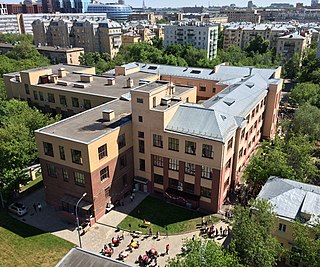
School № 1535 is a secondary school for students of years 7-11 in the Khamovniki District of Moscow, Russia.
Dmitry Konstantinovich Faddeev Academic Gymnasium at Saint Petersburg State University also known as the 45th Physics Mathematics School is a selective secondary boarding school at the Saint Petersburg State University established in 1963 in what was then the Soviet Union, now Russia. In 2015 it was named after Russian mathematician Dmitry Konstantinovich Faddeev, who was one of the founders of the school.
Grigory Yaroslavtsev is a Russian-American computer scientist. He is an assistant professor of computer science at George Mason University. Previously he was an assistant professor of computer science at Indiana University and the founding director of the Center for Algorithms and Machine Learning (CAML) at Indiana University.

















